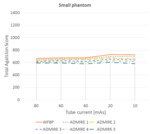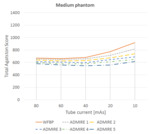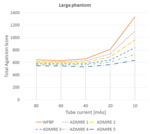Purpose
Introduction
The risk of coronary heart disease-related events significantly correlates with the grade of coronary artery calcifications (CAC),
as measured by non-contrast cardiac computed tomography (CT).
Typically,
CAC scans are reconstructed with filtered back projection (FBP).
Within the last decade iterative reconstruction (IR) techniques have been gradually established in clinical routine.
Purpose of the study
The aim of this study was to assess and quantify the possible dose reduction while maintaining both image quality and Agatston scores using a third generation dual-source CT in combination...
Methods and Materials
Phantom
The study was performed with a commercially available 30-cm-wide anthropomorphic calcium scoring phantom (QRM,
Moehrendorf,
Germany) with a total of six cylindrical inserts (3 inserts of 5 mm and 3 inserts of 3 mm) containing hydroxyapatite at different concentrations (800; 400; 200 mg/cm3).
Each acquisition was conducted three times,
i.e.
without additional attenuation ring,
as well as with smalland largeattenuation rings for simulation of a slim,
average-sized and large patient.
CT scanner & image reconstruction
All scans were performed with a third-generation dual-source CT...
Results
In general,
when lowering tube current,
Agatston scores proved to remain relatively stable between 80 and 40 mAs and increased at lower tube currents,
particularly in the medium and large size phantom (Figures 1 - 3).
This could be compensated for with the IR,
asAgatston scores decreased with increasing ADMIRE levels compared to wFBP (p<0.001).
At a tube current of 10 mAs levels of iterative reconstruction closest to the reference (i.e.
wFBP at 80 mAs) were level 1 in the small (Agatston score 701 vs....
Conclusion
As coronary calcium scoring is a main,
widespread tool for cardiac risk assessment in asymptomatic subjects,
accompanying possible adverse effects,
i.e.
radiation exposure,
should be held as low as reasonably achievable.
The use of new iterative reconstruction kernels may allow for reduction in tube current for established Agatston scoring protocols and consequently for a substantial reduction in radiation exposure.
References
Agatston AS,
Janowitz WR,
Hildner FJ,
et al (1990) Quantification of coronary artery calcium using ultrafast computed tomography.
J Am Coll Cardiol 15:827–832.
Raggi P,
Callister TQ,
Cooil B,
et al (2000) Identification of Patients at Increased Risk of First Unheralded Acute Myocardial Infarction by Electron-Beam Computed Tomography.
Circulation 101:850–855.
Schindler A,
Vliegenthart R,
Schoepf UJ,
et al (2014) Iterative image reconstruction techniques for CT coronary artery calcium quantification: comparison with traditional filtered back projection in vitro and in vivo.
Radiology 270:387–393.
Willemink MJ,
de...




